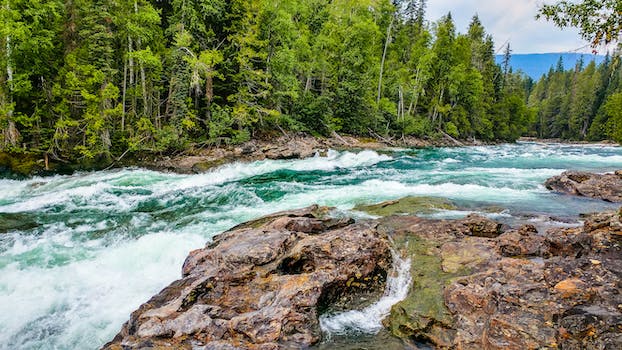There’s nothing like doing water sports in their native habitat to fully appreciate them. Water adventures can take place in a variety of stunning settings all around the world, from the stillness of an alpine lake to the roar of the ocean. These are some of the best water activities to try in natural environments, whether you’re an old pro or just getting started.
- 1. The Benefits of Water Sports in Natural Surroundings
- 1.1. Improves Mental Health
- 1.2. Enhances Physical Fitness
- 1.3. Boosts Immunity
- 1.4. Provides a Unique Experience
- 1.5. Helps to Reduce Stress
- 2. Top Water Sports to Try in Natural Surroundings
- 2.1. Kayaking
- 2.2. Stand-Up Paddleboarding
- 2.3. Canoeing
- 2.4. Wild Swimming
- 2.5. Snorkeling
- 3. Safety Tips for Water Sports in Natural Surroundings
- 3.1. Wear a Life Jacket
- 3.2. Check Weather Conditions
- 3.3. Avoid Alcohol and Drugs
- 3.4. Know Your Limits
- 3.5. Bring a First Aid Kit
1. The Benefits of Water Sports in Natural Surroundings
Water activities are a fantastic way to get in shape and experience the outdoors. There are numerous health benefits to being near water, whether you choose to go swimming, kayaking, or paddleboarding. One of the many benefits is that it helps you relax and feel better mentally. The soothing nature of the river and the surrounding forest might put you at ease. Water activities are not only fun, but they can also be a great way to get in shape and burn calories. There’s also the simple pleasure of being on the water, surrounded by the splendor of nature. Try your hand at some water sports in the great outdoors if you’re searching for a healthy and enjoyable pastime activity.
1.1. Improves Mental Health
Taking part in water activities in scenic settings has numerous positive effects on one’s psyche. The tranquility of the mind can be enhanced by the presence of water, the freshness of the air, and the splendor of nature. Paddling sports like kayaking, canoeing, and stand-up paddleboarding help relieve tension and anxiety because they demand mental and physical concentration and effort. Moreover, studies have found that spending time in nature can do wonders for your mental health. In general, engaging in water sports in beautiful natural settings may be a welcome diversion from the stresses of daily life and a boon to one’s emotional and mental well-being.
1.2. Enhances Physical Fitness
Taking part in water sports in their natural settings is a great way to get in shape. Water sports, such as swimming, kayaking, and paddleboarding, are excellent ways to get in shape because they work the entire body. Swimming is an excellent form of exercise because the resistance from the water makes every step more difficult than it would be on dry land. The mental benefits of being outside in the open air and taking in the sights of nature only add to the many physical advantages of participating in water sports.
1.3. Boosts Immunity
Participating in water sports in natural settings is not only exhilarating, but also has many positive effects on one’s health and well-being. The capacity to improve resistance to illness is one of the main benefits. The production of white blood cells, which fight against infections and disorders, has been shown in tests to be increased by interaction with natural water bodies like oceans, rivers, and lakes. Vitamin D, which is produced by the body in response to sun exposure and is crucial for maintaining a healthy immune system, is another benefit of participating in water sports. If you want to boost your health and immunity, it’s a good idea to go swimming or kayaking in a natural setting.
1.4. Provides a Unique Experience
The Peace Corps is widely recognized as an outstanding international cultural exchange initiative. Founded by President John F. Kennedy in 1961, the Peace Corps’ mission is to foster international understanding and goodwill via the placement of American volunteers in developing nations. Volunteers contribute to many different sectors, including the academic, medical, agricultural, and civic spheres. They stay with host families and learn the language and customs of the nation they are visiting. Volunteering with the Peace Corps gives Americans the chance to serve their country while also learning about other cultures.
1.5. Helps to Reduce Stress
Stress relief is just one of many advantages of participating in water sports in natural settings. The tranquilizing impact of nature, the soothing murmur of the water, and the vigorous exercise of water sports all contribute to a state of calm and relaxation. In addition, participating in water sports is a great way to unplug from the stresses of daily life and focus solely on the activity at hand. In general, engaging in water activities in scenic settings is a great approach to boost mental health and decrease stress.
2. Top Water Sports to Try in Natural Surroundings
American college students can get overseas experience and hone their leadership abilities through the Cultural Vistas Fellowship, which is a prestigious cultural ambassador program. The goal of this program is to encourage cultural interchange and assist students become better representatives of their country abroad. Students can broaden their perspectives on the world and their place in it by participating in the Cultural Vistas Fellowship. Participating in the program will equip you with the language skills, cultural experiences, and networking opportunities necessary to advance your career in today’s international economy.
2.1. Kayaking
In conclusion, cultural ambassador programs are extremely important for increasing worldwide comprehension and developing substantial intercultural connections. These efforts aid in fostering understanding and cooperation amongst communities by introducing people to new ideas and customs. Cultural exchange and communication are becoming increasingly crucial as our global community grows closer together, and cultural ambassador programs are a great way to facilitate this.
2.2. Stand-Up Paddleboarding
SUP, or stand-up paddleboarding, is a great way to get out on the ocean and connect with nature. You may glide effortlessly across rivers, lakes, and even ocean waves with just a board and paddle. Stand-up paddling (SUP) is a low-impact form of exercise that challenges your core, enhances your balance, and lets you see the world in a new way. Stand-up paddleboarding is a fantastic way to get in touch with nature and have fun in the outdoors, regardless of your paddling experience.
2.3. Canoeing
Canoeing is a well-liked water activity because it gives participants the freedom to discover their surroundings at their own leisure. It’s a wonderful opportunity to get some exercise and appreciate nature. Canoeing is an exciting and satisfying activity whether you’re gliding along a placid river or facing the challenge of rapids.
2.4. Wild Swimming
Swimming in natural bodies of water, such as lakes, rivers, and oceans, is what makes “wild swimming” such a novel and thrilling sport. Wild swimming, as opposed to pool swimming, gives its participants a sense of independence and adventure. Connecting with nature and appreciating its splendor is another benefit. However, before diving into the wild, it is vital to take safety steps including verifying water conditions and packing the proper clothing.
2.5. Snorkeling
One of the most common recreational activities in natural environments is snorkeling. Snorkeling is a form of underwater exploration that does not need the diver to retain their breath while exploring the underwater world. If you’ve ever wanted to see coral reefs and marine life up close and personal, this is the right activity for you. You can go snorkeling anywhere from a tiny reef to a deep ocean trench. It’s accessible to people of all fitness levels and ages, making it a great option for solitary vacationers and groups.
3. Safety Tips for Water Sports in Natural Surroundings
Water activities in scenic locations may be exhilarating and revitalizing. Keep in mind, though, that things out in nature can take an unexpected turn for the worse. Some important safety considerations are listed below.
1.Always have a personal flotation device, such as a life jacket, on you.
Check the forecast before setting out, and be prepared for unexpected changes.
Third, only use boats or go swimming in designated places.
Fourth, never embark on a boating or swimming expedition without a companion.
5. Keep an eye out for any dangers, including rocks or currents, while swimming underwater.
Protect yourself from the sun and make sure you drink enough of water.
Seventh, always take into account the advice of experts.
Using these precautions, you can safely participate in water activities in beautiful settings.
3.1. Wear a Life Jacket
It is essential to put safety first when engaging in water sports in undeveloped areas. Wearing a life jacket is a must for your own protection. Wearing a life jacket increases your chances of surviving in the water, even if you are a skilled swimmer, because accidents can happen at any time. Also, before getting in the water, double-check that your life vest fits and is securely fastened. When participating in outdoor water activities, remember to put safety first.
3.2. Check Weather Conditions
When preparing for outdoor water sports, it is essential to first check the weather forecast. To stay safe, you should be aware of the wind’s direction, velocity, and temperature. Before venturing out, be sure to check the forecast and keep an eye on the sky in case the weather takes an unexpected turn. Keep an eye on the weather and be prepared for any changes by carrying a weather radio or a smartphone with weather applications. Always put your safety first when participating in water sports in a natural setting.
3.3. Avoid Alcohol and Drugs
Avoiding alcohol and drugs is one of the most vital safety advice for outdoor water activities. Because of the impairment of judgment and coordination that these substances might cause, they should be avoided whenever possible. Being drunk on the water can be dangerous even if you are not the one operating a boat or other watercraft. Staying attentive, focused, and sober is crucial if you want to enjoy water activities in natural settings.
3.4. Know Your Limits
Knowing your boundaries is essential while participating in water sports in unstructured environments. Taking chances can put you in perilous circumstances, especially if you aren’t a strong swimmer or aren’t familiar with the area. Don’t push yourself past your limits, and always listen to the advice of experts. If you’re nervous or uncertain, it’s safer not to participate. Always put your safety first when participating in outdoor water activities.
3.5. Bring a First Aid Kit
Safety should always be the top priority when participating in water activities in undeveloped environments. Having a first aid kit on hand is a must in case of an emergency. The key to a speedy recovery after an accident is being well-prepared for the unexpected. Bandages, gauze, antiseptic wipes, and pain medications should all be part of your kit. Also, remember to include your inhaler and EpiPen in case of an emergency. If you follow these basic safety measures, you may relax and enjoy your water sports trip without worrying about anything going wrong.
Conclusion
To sum up, participating in water sports in their natural environments is a thrilling and unforgettable adventure that provides a special bond with Mother Nature. Those interested in exploring the sea can choose from a variety of activities, such as kayaking and snorkeling. Grab your gear and dive into the thrilling world of water sports to see the wonders of nature.




